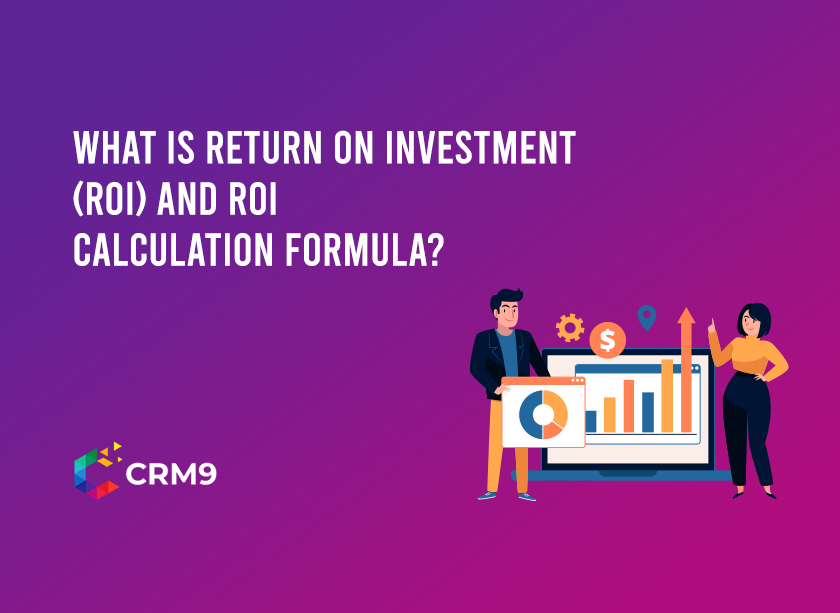When it comes to financial business and finance, profitability measurement is essential to making sound decisions. This is where the best What is Return on Investment (ROI) comes in. Simply stated, ROI is a critical metric that could be employed by individuals and organizations in evaluating the efficiency of investment through the comparison of returns to the cost. This measure is important in business because it helps any business across industries to monitor growth, optimize resources, and sustain profitability. As a startup founder, a marketer, or an investor, you need to know the concept of ROI so you can make smarter financial choices.
This blog will discuss the return on investment definition, its relevance, the formula of ROI, and the viable techniques of how to calculate ROI in sales successfully. We will also discuss variations of ROI, real-life examples, and common pitfalls to avoid when calculating returns—so that you can make sound business and financial strategies in 2025.
What is Return on Investment or ROI?
Return on investment (ROI), in simple terms, is the feasibility of the profitability of an investment relative to its cost. It happens to be one of the most commonly utilized financial indicators to measure the efficacy of a business choice, project, or campaign.
In other words, ROI allows you to know the amount of gain or loss that you have relative to your expenditure. What this means is that, were you to put money in a marketing campaign and make revenue of ₹1500, your ROI sales would be 50%.
One of the major questions that businesses and investors commonly ask in 2025 is what happens to be the return on investment is in the realm of contemporary markets? The answer is simple—it is still about profitability calculation. Nevertheless, the contemporary dynamic environment comprises ROI in digital marketing, sales ROI, and even ROI on sustainable investments.
The meaning of the return on investment is essential when estimating the financial strategies, as it not only gives clarity when the resources are well used, but also it informs the decisions in future budgeting.
Pro Tip:
Recent financial research findings show that 50% of companies who routinely measure ROI on campaigns and projects are better placed to experience greater profit margins, and this is attributed to systematic measurement of returns.
Why is ROI Important?
The definition of the return on investment simplifies the matter- ROI is all about efficiency and profitability. Why is ROI such an important measure in 2025, though? The solution is in its flexibility and capability of directing smarter financial choices.
Key Reasons ROI Matters:
- Decision Making: ROI assists the investments and companies in comparing the different opportunities and selecting the one that is most profitable.
- Performance Tracking: A business can gauge the success of their campaigns, sale programs or any other long-term investment by calculating ROI on a timely basis.
- Budget Allocation: ROI will help organizations to make investments on projects that will give the highest returns.
- Risk Reduction: ROI reduces the amount of guesswork by showing the actual outcomes compared to estimations and enhances financial planning.
- Business Growth: You may be wondering what ROI is in business or the difference between IRR and ROI, but regardless, this metric has a direct impact on long-term growth plans.
How to Calculate ROI?
The formula to calculate return on investment, various variations, the common errors and the real-life examples to simplify the process of applying ROI in real-world situations? The traditional equation of the return on investment is
ROI = Net Profit / Cost of Investment x 100
This is the simple ratio that demonstrates the percentage of the return. However, investors tend to question, how do we compute ROI in real-life situations? Let’s break it down.
Step 1: Determine Net Profit
Net Profit = Total Revenue – Total Cost
Step 2: Divide by Investment Cost
Divide your profit by the cost incurred.
Step 3: Multiply by 100
The result is your ROI percentage.
Example:
If you spend 5,000₹ on a digital marketing campaign and earn 8,000₹ in revenue, your net profit is 3,000₹.
Net Profit = 8000 – 5000 = 3000
ROI = (3000 ÷ 5000) × 100 = 60%
That’s how you calculate return on investment effectively.
Did You Know?
ROI is a rather ancient financial measure, and one can even trace the origins of its usage in business records to the 19th century. It is one of the what is roi in business in 2025 despite its age.
List of Return on Investment Examples
The practical examples given make it far easier to comprehend what is actually meant by return on investment and how that applies to the various industries. ROI is not confined to any given kind of investment; it can be implemented on marketing campaigns, stocks, real estate, business operations and even on the training of employees.
1. Marketing Campaign ROI Example
Take the case of a business that spends 10,000 INR on an online advertisement campaign. Upon carrying out the campaign, the company would earn 25,000 as revenue. The profit net of this initiative is 15000. Using the ROI calculation formula, the ROI is 150%.
This example demonstrates the importance of businesses in measuring the success of marketing campaigns and determining whether the same campaigns will be effective again. Application of ROI in marketing makes sure that the funds are used efficiently and also the campaigns are optimized to give maximum returns.
2. Stock Market ROI Example
In investment, the knowledge base of how to compute the ROI is important in evaluating performance. An example is you buy shares at the price of ₹1,000 and sell them later at a price of ₹1,200. The ROI is 20%, which gives a net profit of ₹200.
This calculation is used by investors to compare various stocks, to analyze risk and to calculate which assets are performing best. Periodic computation of ROI guarantees smarter management of the portfolio and decision-making.
3. ROI in Real Estate
ROI also works on the real estate investments. In the example in which an investor bought a home at 200,000₹ and sold it at 250,000₹. The net profit of the company is 50,000, and the ROI is 25%.
This will indicate to the property investors whether the purchase was worth it in the long term, weighing against other properties and forecasts on possible returns that can be realized in future investments. Examples of return on investment meaning in real estate focus on the need to ensure that the purchase costs and other expenses, such as maintenance costs and taxes, are taken into account.
4. ROI in Sales
Companies are able to determine ROI on projects such as employee training. In the case of an example, a company spent ₹2,000 in training the sales team activity log, after which it earned the company an extra revenue of ₹6,000. This gives a net profit of ₹4,000, resulting in an ROI of 200%.
This example is used to explain why ROI is an important calculation to justify the use of resources, tools, or personnel by businesses. After understanding how to calculate the payback, the managers will be in a position to make evidence-based decisions that will increase efficiency and profitability.
Key Takeaway
These examples of ROI returns demonstrate the flexibility of ROI. ROI assists businesses and investors to determine how their investments perform, make better decisions, and allocate resources efficiently whether in marketing, financial markets, real estate or sales.
Different ROI Formula Variations
Although the standard ROI formula is easy, contexts demand particular strategies. The average annual ROI of the S&P 500 is generally 10%, and it varies greatly by industry; a high ROI is typically thought to be above 10%. We will take a look at a few variations.
A. ROI in Sales
To know how to calculate return on investment in sales, concentrate on the revenue obtained by campaigns relative to investment.
Formula:
Sales ROI = Revenue from Sales – Cost of Sales / Cost of Sales x 100
Example: When a sales campaign has cost ₹1000 and yielded ₹3000, then ROI = 200%.
Net Profit = 3,000 – 1,000 = ₹2,000
ROI = (2,000 ÷ 1,000) × 100 = 200%
B. ROI in Business
To determine what ROI means to business, one must take into consideration the cost of operation, employee cost, and marketing.
Formula:
Business ROI = Net Profit / Total Business Expenses x 100
Example: A startup will invest ₹50,000 and make profits of ₹75,000 then ROI = 50%.
Net Profit = 75,000 – 50,000 = ₹25,000
ROI = (25,000 ÷ 50,000) × 100 = 50%
What are the Common Mistakes in ROI Calculation?
ROI may seem straightforward; however, a lot of mistakes can be made by the business, which can cause incorrect conclusions. Knowing what constitutes a return on investment is not the ultimate goal, but it is important to calculate it properly. The following are some of the most typical errors made by companies and investors in using RO.
1. Confusing Profit with Cash Flow
Cash flow is not profit. The ROI must always be determined by real net profit, not estimated flows of cash. Failure to recognize this difference may create a false impression of the performance of an investment.
2. Ignoring Costs
Most ROI calculations do not take into account key costs like operation costs, taxes or transaction costs. Not taking these into consideration decreases accuracy and may lead generation to overestimating the returns.
3. Omitting Hidden Costs
Indirect costs should always be incorporated in ROI calculations, such as licensing fees, maintenance expenses, delivery costs, and so on. By ignoring such hidden costs, one can make an investment look more attractive than it really is.
4. Overestimating Revenue or Returns
Positive prediction is a pitfall. The estimated income or returns do not always become a reality, and valuing ROI by computed, overstated figures can translate into ill-informed business decisions.
5. Ignoring the Ramp-up Phase
New businesses or project management usually need time to give significant returns. ROI may make an investment seem underperforming in the short run when it is really doing well in the long term due to calculation too soon, without taking into account the ramp-up period.
Conclusion
ROI has been one of the most helpful financial decision-making tools. Are you investigating ROI (return on investment) in sales, scrutinizing stock market returns or looking at business performance, knowing what ROI is will enable you to mitigate risks and maximize profits. Using the ROI calculation formula, businesses and investors can calculate the opportunity to make the right decisions, make smarter decisions, and align strategies and long-term objectives. In 2025, ROI will be smarter with more data being collected, with more analytics and being integrated with digital platforms- this will make the decision-making process quicker and more accurate.
Related Reads
- Sales Organization Structure: Types, Purpose & Hierarchy Explained
- What is Sales? Sales Meaning, Types, and Importance Explained (2025 Guide)
- Sales Analysis Explained: A Complete Guide to Sales Data and Trends
- Inbound vs Outbound Sales | Difference, Meaning & Strategies Explained 2025
- What is a Sales Plan? Process, Strategy & Templates Explained
- Inside Sales Explained: Meaning, Key Roles, and Responsibilities
- Sales Report: Easy Steps, Benefits & Excel Tips for Success


